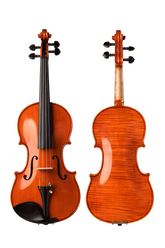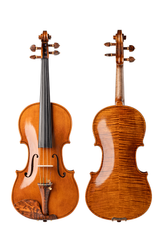Violin Peg Problems: Causes and Solutions
When musicians reach out to us with tuning troubles, eight times out of ten the problem lies with the violin pegs. Few things are more frustrating than pegs that either keep slipping or refuse to turn. Why is it so difficult to find the right balance?
Although proper fitting technique is crucial, remember that the violin is made of wood. With frequent tuning, the pegs and pegbox naturally wear down. Every turn of a tapered peg creates friction and pressure, slowly changing the fit. Still, with correct use and regular maintenance, pegs can last for many years.
Below, let’s look at the most common peg problems, their causes, and how you can prevent them.

1. Slipping Pegs
One of the most common complaints is pegs that slip. Players notice that the peg keeps pushing deeper into the hole, yet still won’t hold the string in tune. This happens because repeated force makes the peg smaller while the hole becomes larger, reducing its lifespan. Uneven wood density also causes wobbling (see Figure 1).
A frequent cause is using too much peg compound. The peg and hole should fit perfectly without gaps, and only a small amount of compound is needed. Too much makes the peg spin too freely, forcing it deeper into the hole. Too little, on the other hand, makes it stiff and accelerates wear.
👉 Tip: Apply peg compound sparingly for the best balance.
2. Wrong Angle or String Winding
Sometimes pegs pop out of the pegbox without warning. This usually happens when the string is wound too far from the pegbox wall. Because pegs are tapered, the outward pull forces them out (see Figure 2, G peg).
The ideal winding keeps the string close to the wall, but not touching it (see Figure 2, D peg). Improper winding can also make pegs stiff or uneven to turn. In the worst case, the string presses against the wall, making tuning nearly impossible and even cracking the pegbox (see Figure 2, A peg).
👉 Tip: Trim strings to about 1 inch (2.54 cm) so they don’t press against the wall. If the handle angle feels awkward, increase the length of string through the peg hole by about 0.25 in.
3. Broken Strings
Strings that wind on top of each other or rub against neighboring strings can easily break. This often happens between the A and D strings when peg-hole placement is off.
Figure 3 shows the correct peg-hole positioning, which prevents friction and ensures stable tuning.
👉 Tip: Always check winding order and avoid overlapping.
4. Climate and Humidity
Musicians who travel know that changes in temperature and humidity affect pegs. When humidity drops, the wood shrinks: pegs get smaller, holes get larger, and you must push the pegs in deeper. When humidity rises, the opposite happens and pegs become extremely tight.
👉 Tip: Give your instrument time to adapt to new environments. A case humidifier can also help.
5. Regular Maintenance
Because wood hardness varies, wear and misalignment are inevitable over time. Pegs and peg holes must occasionally be reshaped, or replaced entirely.
-
New pegs should be slightly thicker than the old ones.
-
If holes are too large, a luthier can patch and reposition them.
-
Cracks around peg holes require more advanced repair.
👉 Tip: If you notice slipping, stiffness, or cracks, visit a professional repair shop before the issue worsens.
6. How to Tune a New Violin: Peg Basics for Beginners
For students with a brand-new violin, tuning can feel tricky. Unlike fine tuners, pegs require a special technique: press and turn at the same time.
Steps for correct peg usage:
-
Insert the string through the peg hole, leaving about 0.25 in (6–7 mm) of string sticking out.
-
Start winding by turning the peg inward toward the pegbox wall for a neat coil.
-
Apply gentle inward pressure while turning. This pushes the tapered peg into the hole, allowing it to grip firmly.
-
Tune slowly and stop near the desired pitch. Avoid forcing the peg too deep.
-
Use fine tuners (if available) for precise adjustments.
Beginner Tip: Never turn a peg without pressing inward, or it will slip. Too much pressure will jam the peg. Balance is key.
With practice, this technique becomes second nature, and your violin stays in tune reliably.
Conclusion
Understanding how violin pegs work—and how to properly care for them—can save you from frustration and costly repairs. From slipping pegs to learning the basics of tuning a new violin, the key is balance, maintenance, and patience.
🎻 Looking for a beginner-friendly violin that’s easy to tune? Our Fiddlover Q033 Student Violin is carefully set up by luthiers to ensure smooth tuning and reliable performance, making it the perfect choice for new players.





